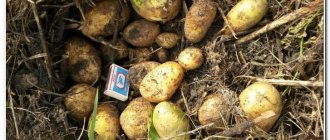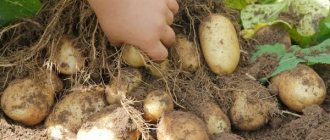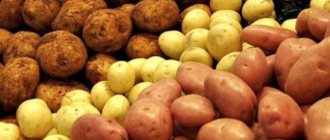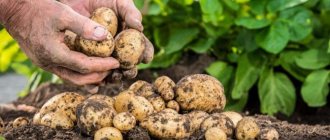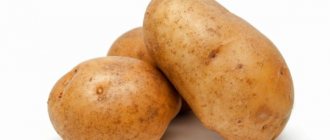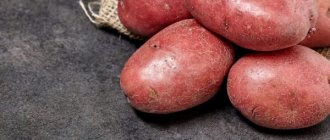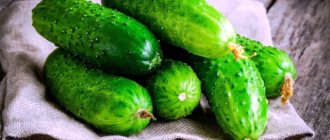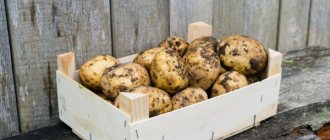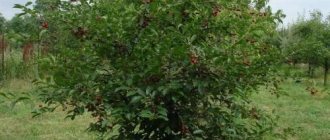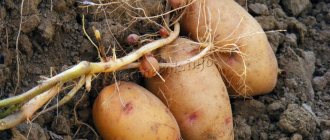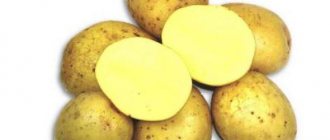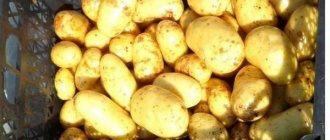Not all Russians’ vegetable gardens and summer cottages are large; most often, the owner has only a couple of acres at his disposal. When allocating space on this piece of land, gardeners often “forget” about potatoes, since there is hardly enough space for tomatoes, cucumbers and herbs. It is believed that in order to get a good potato harvest, you need to plant several buckets of this root vegetable, and such an amount requires a fairly large garden area.
In this case, Dutch potatoes will be a real salvation. The yield of these potatoes is 3-4 times higher than that of Russian varieties, which means that from one hundred square meters you can get about 120 kg of root crops.
Ripening time and yield
The ripening period of Dutch potatoes is generally average. The Dutch has two degrees of maturity (depending on the variety):
- young potatoes - from 40 to 60 days (the earliest Riviera variety is ready for consumption already 40-45 days after planting);
- Full maturity occurs 70-80 days from the moment planting material is planted in the soil.
Note! Most Dutch varieties can be classified as early or mid-season potato varieties. Productivity is traditionally high, from 2 to 3 kg per bush with proper agricultural technology.
Dutch potatoes are considered early ripening
Variety "Prior"
Potatoes of this variety are characterized by early ripening, good keeping quality of tubers and high yield. It was developed relatively recently, but managed to gain popularity among vegetable growers. The tubers are distinguished by their elongated, regular shape with a smooth surface and a small number of eyes. The pulp is light cream in color, its starch content is 10-12%. "Prior" is a potato with complex resistance to viral and bacterial diseases, as well as potato nematode.
Disease resistance
The Riviera variety does not suffer from potato cancer, Yntn, Yn viruses, or golden nematode. But ordinary scab and both types of late blight (tops and tubers) are dangerous for the variety.
The Scarlett variety often suffers from late blight of the tops, but has increased resistance to common scab and potato Y-viruses. Resistance to late blight of tubers, cancer and nematodes is high.
Latona's immune system helps her successfully cope with potato canker, golden nematode, tuber late blight, and dry rot. Resistance to late blight of tops and scab is much lower.
Gala has low resistance to the PLRV virus, which causes leaves to curl, as well as late blight of tops. This variety is more resistant to tuber blight, blackleg, and nematodes.
Late blight of tops can destroy an entire potato field in a matter of days.
Red Scarlet
Potato variety from Holland for beginners. All summer residents can cope with growing Red Scarlet, there are no failures. The ability to be stored for a long time is an important feature of the Red Scarlet variety.
Characteristics of Red Scarlet tubers:
- peel color - red;
- pulp color: yellowish;
- medium-sized tubers weigh 100–120 g;
- classic oval and slightly elongated shape;
- eyes are shallow;
- starch percentage ranging from 10 to 15%;
- They are stored well and do not suffer from rot for a long time.
Information for cooks: the pulp may crumble during cooking; potato tubers of the Red Scarlet variety of Dutch selection are best used for puree, filling in pies, shangi, dumplings. Red Scarlet makes delicious casseroles.
Important! Plant potatoes taking into account crop rotation. Good predecessors for it are all cereals and any legume.
The agricultural technology is simple: loosening the soil, killing weeds, watering, fertilizing. The planting pattern is 35x75 cm. The growing season is short - from 45 to 55 days. When planting in early spring (mid to late April), the Dutch Red Scarlet potato variety is harvested in June. The yield is convincing; summer residents, according to reviews, dig up 19 kg of large potatoes per square meter. Resistance to nematode damage is noted.
Characteristics of tubers, description of appearance
The description of the appearance of root vegetables depends on the variety.
Gala has round or slightly elongated tubers weighing from 70 to 120 g. The peel of the variety is yellow with a smooth mesh surface. There are few eyes, the maximum depth is 1.3 mm. The pulp is yellow.
Gala
Latona tubers are also round and smooth with a thin yellow skin. The pulp is cream or light yellow. The weight of the root crop reaches 140 g.
Latona
The skin of Riviera root vegetables is light beige, slightly rough, with shallow, small eyes. The pulp is creamy. Tuber weight is from 100 to 180 g.
Riviera
Scarlett's red tubers are oval-shaped with a smooth mesh surface, small and shallow-lying eyes. The pulp is yellow.
Scarlett
For your information! Dutch potatoes are suitable for cultivation throughout almost the entire territory of Russia, excluding the northernmost and southern regions. Weakly responds to changes in weather conditions, drought-resistant. The climate of Central Russia is best suited.
Variety "Condor"
Introduced into culture since 1995. Early variety, table variety.
The bush is powerful, erect, tall. The flowers of the plant are rich, dark red with a purple tint. The oval tubers have an even shape with a red skin and light yellow pulp, the starch content ranges from 9-14%.
It is characterized by average resistance to viruses, common scab, and susceptibility to late blight. The variety is valued for its high and stable yield and high marketability of tubers.
The main advantages and disadvantages of the variety
The undoubted advantages of Dutch seed potatoes include:
- high productivity;
- short growing season, so you can harvest two crops per season;
- can be collected not only by hand, but also using a potato digger;
- good taste;
- high resistance to potato cancer, nematodes, potato Y-viruses;
- versatility of culinary use;
- good presentation and optimal tuber size;
- keeping quality over 95%;
- easy adaptation to weather conditions of different climatic zones.
The Dutch potato variety also has disadvantages:
- if the harvest is not harvested on time, the peel of most varieties becomes very rough;
- all Dutch varieties cannot grow in one place for more than 3 years in a row;
- you need to often purchase new planting material, since in 2-3 years the variety loses its taste. In addition, if you use last year's harvest as planting material, the tubers of the future harvest will become smaller.
Note! Almost all Dutch potatoes are not resistant to top blight.
Dutch potatoes: 5 most productive varieties
Don’t believe that you can collect more than 10 (!) large bags of potatoes from one hundred square meters?! Plant one of the productive varieties of Dutch potatoes on your plot and see for yourself the reality of these numbers!
A small plot of land or summer cottage is not a reason to refuse to grow “second bread” in favor of other crops. It is much more reasonable to allocate the main part of the land plot for planting the same cucumbers, tomatoes, carrots, strawberries or berry bushes, and occupy one small bed with a super-yielding variety of Dutch potatoes.
Main benefits of Dutch potatoes
The most important advantage of Dutch potato varieties is their unprecedented yield. Thus, in temperate latitudes it will not be difficult to obtain 400-500 centners of elite and super-elite tubers per hectare. If these varieties are grown on the chernozem soils of southern Russia, then from each hectare you can collect up to 600-800 (!) centners of selected potatoes.
In Russia, the most widespread are mid-early varieties of Dutch potatoes, whose root crops form quite early.
Dutch potato varieties, as a rule, are resistant to viruses, various pathogenic types of potato nematodes and cancer, and some are not afraid of common scab. But late blight affects the tops of these crops not so rarely, but their tubers are resistant to this disease. To minimize the likelihood of the spread of a fungal disease, be sure to treat potatoes with fungicides during the growing season.
Unfortunately, not all Dutch potatoes grow and bear fruit well in our climate. To make it easier for you to choose good planting material, we offer an overview of 5 high-yielding varieties of Dutch root crops.
Impala
A variety that will delight you with consistently good harvests in both cold and hot years. Under each bush you will find from 10 to 20 tubers.
Oval, covered with a smooth light yellow skin, they are not afraid of mechanical damage, are perfectly stored and even at high temperatures in storage do not germinate for a long time. You will also be able to appreciate the taste of these potatoes. Even after cooking, the tubers retain their color and shape perfectly.
Impala bushes are little susceptible to nematodes, scab, viral diseases, and cancer pathogens. Perhaps the only thing you should be wary of when growing this crop on your plot is late blight pathogens. As soon as the leaves of the plants begin to become covered with characteristic spots, the growth of the tubers will stop. To prevent such a scenario from happening, take preventive measures in a timely manner.
| Purpose | Productivity (kg/100 sq.m) | Tuber weight (g) | Growing season (days) | Flesh color |
| 500 | 90-150 | 60-70 | yellow | |
Condor
The Condor potato variety not only has a sonorous name, but also good taste. Red tubers with light yellow flesh are great for frying, boiling and baking. And peeling them is a pleasure: fairly large root vegetables with a regular oval shape are comfortable to hold in your hand. Despite the fact that there are not so many potatoes under the bush, their size is impressive.
Plants tolerate drought well and are resistant to cancer pathogens, but have average susceptibility to late blight, scab, and viral diseases. Tubers are not afraid of mechanical damage and tolerate winter storage quite well.
| Purpose | Productivity (kg/100 sq.m) | Tuber weight (g) | Growing season (days) | Flesh color |
| 350 | 120-140 | 80-90 | light yellow | |
Latona
If you prefer yellow potatoes, be sure to plant the Latona variety on your plot. Oval-round tubers are mostly medium in size, but the weight of some specimens reaches 140 g. Therefore, it is quite simple to collect up to 2.4 kg of tubers from one bush, which are well stored and can withstand transportation.
The growing season of Latona is 70-75 days. Despite this, you can pamper your loved ones with young potatoes 45 days after planting the tubers.
Plants of this variety have adapted well to the climate conditions of the middle zone: they are not afraid of either drought or heavy rains. The culture is resistant to viral diseases, as well as golden nematode and dry rot. However, without proper care, plant tops may suffer from late blight.
| Purpose | Productivity (kg/100 sq.m) | Tuber weight (g) | Growing season (days) | Flesh color |
| 500 | 90-120 | 70-75 | yellow | |
Red Scarlett
This variety is popular in many countries and is rightfully considered one of the best potato varieties of Dutch selection. Why is he so good?
One of the main advantages of Red Scarlett is its early ripening: you can taste new potatoes already on the 45th day, and start harvesting 75-80 days after planting.
Many gardeners prefer this particular variety because of its high resistance to diseases and pests, mechanical damage, as well as natural disasters, in particular drought. This “survivability” of plants will allow you to reap good harvests even with minimal care and in the leanest years.
Tubers of this variety are distinguished by good presentation. They are medium or large in size, oblong, red; their surface is smooth, even with a small number of eyes. The soft yellow pulp does not change color when cooked and practically does not soften.
| Purpose | Productivity (kg/100 sq.m) | Tuber weight (g) | Growing season (days) | Flesh color |
| 500 | 90–130 | 70-75 | yellow | |
Ukama
The tubers of this variety have an elongated shape and are quite large in size (the weight of the largest potatoes can reach 170 g). When cooked, they do not become soft, and the color of their flesh remains the same, light yellow.
Mechanical damage caused to tubers during digging and transportation quickly heals and does not in any way affect the keeping quality of the crop.
The plants are not attacked by potato nematodes, are not afraid of cancer pathogens, and have average resistance to scab and leaf curl.
The only significant drawback of this variety is that it is not very well adapted to high temperatures. To harvest a good potato harvest in hot years, you will have to actively water the bushes.
| Purpose | Productivity (kg/100 sq.m) | Tuber weight (g) | Growing season (days) | Flesh color |
| 350 | 120-150 | 50-60 | light yellow | |
The Dutch potato varieties we described are rightfully considered one of the best in their group. However, they can only reach their potential with proper care. If you
If you want to harvest a large harvest of large and beautiful tubers every year, do not neglect basic agricultural practices and do not grow potatoes in one area for more than 3 years.
Planting and growing Dutch potatoes
Although Dutch varieties are unpretentious, compliance with soil requirements, rules, timing and planting patterns will ensure a higher yield.
Preparing for landing
Before planting, root crops must be germinated. To do this, select small fruits without any mechanical damage, not wrinkled and not affected by diseases and pests.
Hollandaia germinates well; it is enough to scatter the root vegetables in one layer in boxes or even hang them in nets in a warm, well-lit room. To speed up germination, fruits can be sprayed with growth stimulants (for 2-3 days).
Note! It is necessary to constantly turn the tubers so that they are illuminated from all sides.
Sometimes a wet germination method is used, when the root crops are placed in a leak-proof container covered with sawdust or peat.
The entire germination process takes 4-5 weeks, this must be taken into account and you need to start preparing in advance so as not to miss the moment of planting. Before planting, tubers are treated with fungicides.
Potato germination lasts 4-5 weeks
Soil requirements
Can grow on almost any type of soil. But a good harvest with minimal costs can only be obtained on black soil. All other types of soil require frequent fertilization.
Dates, scheme and rules of planting
Dutch potatoes can only be planted when the ground warms up to 5 °C. Choose a well-lit place.
In the fall, the area where potatoes will be planted is dug up and fertilized with ash and humus. During spring digging, the soil is disinfected with a solution of potassium permanganate and fungicides.
The main rules of Dutch technology
In order for there to be a lot of potato tubers and their quality to be impeccable, it is important to strictly observe the basic requirements and conditions. The basis of the technology is the strict execution of all steps, the use of the highest quality products and long, painstaking work
What varieties are allowed to be used?
To obtain Dutch-level potato yields, only the best potato varieties with high yields and tuber quality are used. Those for which even standard indicators speak of 40 tons of yield per 1 hectare, which in itself is a very good result. And with the correct implementation of the technology, this volume can be doubled and even more.
Of the most common varieties that can be used, the following stand out:
- "Impala"
- "Red Scarlett"
- "Mona Lisa"
- "Romano"
- "Sante"
Variety "Impala"
Variety "Red Scarlett"
Potato variety "Mona Lisa"
Potato variety "Romano"
Variety "Sante"
However, these are far from the only potato varieties that can be grown using Dutch technology. Upon careful study of the characteristics, the use of other varieties is allowed, but you must always remember that the performance must be impeccable.
Planting material
Without a doubt it must be:
- extremely healthy, that is, not a carrier of scab, late blight and other diseases;
- the need to change the variety of potatoes grown every 4-5 years is critical;
- not be damaged by various pests;
- planting tubers should be no more than 5 cm (and no less than 3 cm) in diameter;
- their germination rate should be above 95% (only this quality of planting material is suitable, deviations are unacceptable).
Conditions and planting scheme
A special scheme for placing tubers is of great importance, and especially protection from various pests and diseases. We can safely say that this point is critical for obtaining a good and high-quality harvest.
The use of fertilizers is also carried out in strict accordance with the selected potato variety and its individual needs. Moreover, the technology clearly regulates the timing and frequency of hilling, as well as the height of ridge formation.
Timely harvesting
The process contains a key nuance: if the harvest is carried out with the aim of obtaining seed material, then this is done almost a month earlier (relative to harvesting for food purposes).
This is just a superficial description of Dutch technology. Next, we will look at the basic process of growing potatoes in detail.
How to properly care for the variety
All Dutch varieties are large-fruited and require high-quality watering for their development. It should be plentiful. But before the next watering, the soil should dry well. There is no need to turn a plot of potatoes into a swamp.
Feeding and fertilizing
Poor soil types need fertilizing. Here they add humus, a mixture of potassium salt with superphosphate, a solution of chicken manure, or make do with a ready-made mineral mixture.
Hilling and weeding
Hill up twice during the growing season. The initial hilling (to a height of 3-4 cm) is carried out when the bush has reached 17-19 cm. When the bush rises to 27-30 cm, the second hilling is carried out to a height of up to 20 cm.
Important! It is better to weed the weeds by hand, since herbicides, especially those based on metribuzin, affect the tops of the Dutch plant.
Mid-early
Potatoes of mid-early varieties ripen in 50-65 days. It is recommended for cultivation in temperate climate zones. Dutch breeders protected it from cancer, scab, and increased resistance to late blight and nematodes. Which potatoes are most in demand:
- Latena - distinguished by voluminous bushes, good yield, and good keeping quality. One bush grows up to 15 root crops, with a total weight of 3 kg. On an area of 1 m2 you can grow 4.6 kg. The fruits have a high starch content. The potatoes are tasty, crumbly, suitable for making mashed potatoes and casseroles. The culture is characterized by increased resistance to late blight of tops and root crops;
- Anosta - the crop is grown in all regions. Dutch potatoes Anosta can grow both on chernozems and on sandy loamy soils. Starch content 20%. Gardeners note an average yield of 3 kg/m2. The vegetables are tasty and crumbly after cooking. Breeders protected the plant from nematodes of all types. The crop is moderately resistant to scab and fungal diseases, is well stored in winter, culling rate is 6%;
- Yarla - the crop withstands drought well. The variety is recommended to be grown in the regions of the Lower Volga region. The highest yield was obtained by gardeners in the Tula region, 660 kg/acre. Tubers are slightly affected by late blight and scab, do not suffer from cancer, but cannot resist nematodes;
- Evolution - root vegetables are tasty, contain a lot of starch, carotene, and ascorbic acid. Farmers receive 590 centners of vegetables per 1 hectare. From one bush you get 1 kg of root vegetables, each weighing 150 g. The peel is red, the surface of the fruit is smooth. Large eyes are noted, but there are only a small number of them on the surface.
Mid-early varieties are planted in cool soil. It should warm up to 8 C at a depth of 15 cm. Planting is carried out at the end of April or at the beginning of May. To grow potatoes, seedlings 5-7 cm long are used. It is recommended to germinate them in a dark room. When germinated in the sun, root vegetables will immediately form foliage. Productivity will be reduced.
How to harvest and store crops
The time for harvesting comes when the tops turn completely yellow and begin to wither. If you delay harvesting, the presentation of the potatoes will be much worse: they will become lumpy and the skin will become rough.
You can harvest either manually or using a walk-behind tractor, since Dutch varieties are resistant to mechanical damage.
They dig Dutchwort only in dry, warm weather. The dug up root vegetables are immediately laid out in a well-ventilated, dry room to dry. Drying time is at least 2 weeks.
Note! To speed up drying, the root vegetables are laid out in one layer.
Next you need to sort the potatoes. Sluggish and spoiled fruits are thrown away immediately; they will not be stored.
Storage features and keeping quality of the Dutch variety
The shelf life characteristics of this varietal group are high, up to 98%. Store potatoes at a temperature no higher than 3 °C and a humidity of at least 70%.
Variety "Picasso"
Medium-late ripening potatoes of Dutch selection with outstanding taste and long shelf life.
The plant is powerful, tall, with abundant flowering. The oval tubers have a thin yellow skin with pink spots.
Gives a stable and abundant harvest. However, it is sensitive to poor soils; similar potato varieties (Dutch, etc.) require an increased rate of fertilizer to be added to the soil. Resistant to drought and high air temperatures, viruses, potato nematode, scab, fusarium, late blight of tubers and tops.
Santa
The Dutch table variety is an excellent raw material for making French fries and delicious chips. The pulp contains a small percentage of starch - 12%. The ripening time for Sante falls under the classification of an early variety; it is 80–90 days from germination. The peel is yellowish, smooth, and moderate in density. The flesh is a pleasant pale yellow color. There are many ocelli, but they are almost invisible and shallow. Sante has even tubers; they have an absolutely regular oval (oval-round) shape.
Sante potatoes are recommended for summer residents and farmers; thanks to their durable skin, the potatoes do not get damaged during mechanized harvesting. In the market, this popular Dutch potato variety is in demand for its good, rich taste. A big plus is that the pulp does not change color during cooking.
One bush produces 15–20 potatoes weighing 100–150 g. For a good harvest, Santa requires watering and timely feeding. To prevent harmful substances from accumulating in root crops, it is necessary to constantly alternate mineral and organic fertilizers.
Prolonged heat can reduce the size of root crops and their quantity. The Sante variety has been in the state register since 1993, the regions of the Russian Federation recommended for cultivation are: Central, Volga-Vyatka, Northern, Northwestern, Lower Volga, Ural, West Siberian, Far Eastern. Important information: seed potatoes must be completely replaced every 5 years.
Harvesting
First, the area should be cleared of tops and weeds. Then they carefully dig up each bush with a shovel, clear the tubers from the soil and sort them. This method is good for small gardens, but if the land area is large enough, then they resort to the help of special diggers and tractors.
We invite you to familiarize yourself with potato varieties that have different ripening periods:
| Late ripening | Early ripening | Very early | Mid-late | Mid-early |
| Nikulinsky | Borovichok | Forty days | Crane | Yanka |
| Cardinal | Elmundo | Karatop | Sorcerer | Giant |
| Rocco | Felox | Riviera | Mozart | Tuscany |
| Kiwi | Bellarosa | Zhukovsky early | Grenada | Purple Haze |
| Ivan da Marya | Natasha | Farmer | Melody | Openwork |
| Picasso | Ariel | Minerva | Margarita | Santana |
| Asterix | Queen Anne | Veneta | Ramona | Desiree |
| Slav | Arosa | Kiranda | Dolphin | Lady Claire |
